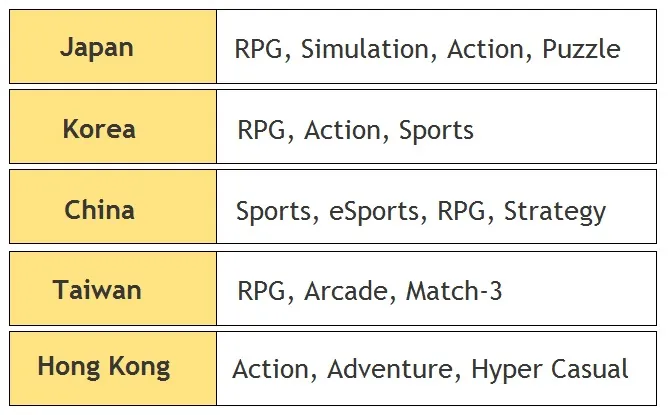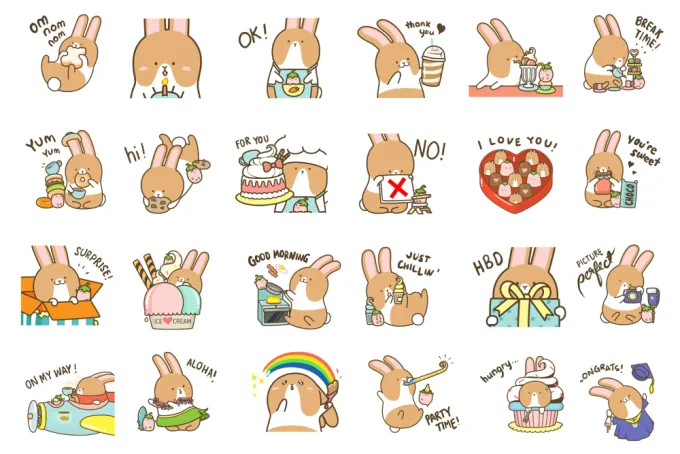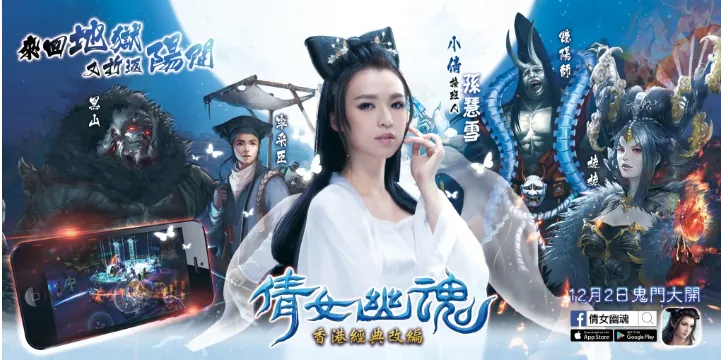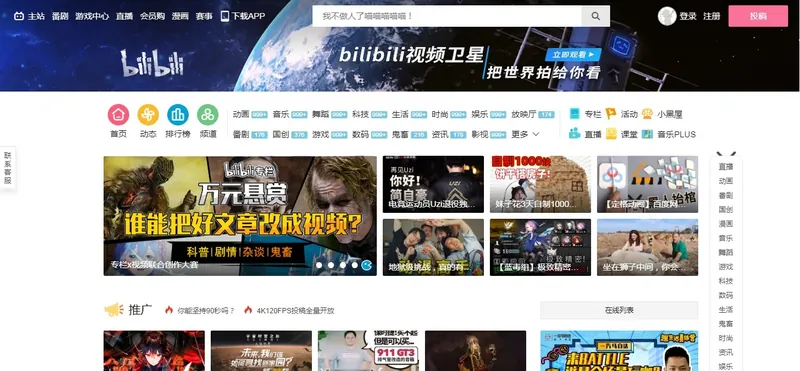.webp)
Asia is a real plum for mobile game developers. Western markets have long since become oversaturated and growth has slowed, but the Asian market continues a trend of dynamic growth. The question is how to get on board.
In this article we’ll be talking about trends and methods of promoting mobile games in Korea, Japan, China, and other Asian countries. Here at Nitro, a professional text translation service, we turned to our friends at WeQ — a German company that specializes in mobile game promotion and attracting quality audiences worldwide, which has direct partnerships with Huawei, Yahoo! Japan, and Tiktok. In preparing this article we were assisted by Ara Jo and Yu Ting Witzko, both of whom are not only well acquainted with the Asian market but were actually born and raised in Asia — Ara in Korea, Yu Ting in Taiwan.
What types of games are the most popular?
Games are tremendously popular in Asia: in 2019 the populace of the Asia-Pacific region spent over $70 billion on games, which currently accounts for half the global games market. Most of this revenue came from China, Japan, and Korea.
Here are the most popular mobile game genres by country:

RPG is a popular genre in many Asian countries. Hyper-casual games are another high-interest category.
Chinese players are often fond of eSports games, and Shanghai and Hong Kong regularly host offline eSports matches. This is linked to China’s strong tradition of team play: the Chinese enjoy doing things as a group.
Dominant stores
In Western countries things are very simple: you have Google Play and the App Store, period. Asia, however, is a little different. For example, China has the App Store, but Google and all its services are prohibited. In place of Google Play (and accounting for 70% of the mobile market) there are around 400 local Android stores. Interestingly, each of these stores has its own focus, with some publishing games exclusively. Working with these stores is easiest through local publishers. More on that later.
In Japan the App Store dominates, while Google Play reigns supreme in Korea, but both countries also have alternative stores. For example, one of the biggest Android stores is Korea’s OneStore. Taiwan and Hong Kong have both the App Store and Google Play.
One way to stand out among other apps is through featuring. WeQ partners with Huawei and can arrange for featuring in Huawei’s store — the App Gallery — in the following categories: New Apps we Love, New Games we Love, and Top-Rated Apps.
User purchasing power
Japan is the most attractive country in terms of profits, with over 70 million smartphone owners, users who are ready and willing to pay (nearly half of all players spend money on mobile games), and a high ARPU (average revenue per user) — $200. Compare this to the ARPU in the USA ($72), China ($40), and South Korea — $108 (source Statista).
Interestingly, in Japan women spend money on games more readily than men, and so many companies create games and marketing campaigns that specifically target female consumers.
As with every country, players in Asia prefer the freemium model. However, users are willing to pay for quality apps and the ability to customize.
Speaking of purchasing power, it should be noted that many users in Asia are not accustomed to paying by credit card. In China people use WeChat Pay and Alipay for in-app purchases; in Vietnam the electronic wallets MoMo, ZaloPay, and VTCPay are preferred; and in Korea Kakao Pay was recently added as a payment option in the App Store.
Promotional channels
Social media

*The messaging app Line is also popular in Indonesia and Thailand.
As you see, China has no Western platforms whatsoever: they are all blocked. But such is not the case in Taiwan and Hong Kong, as these are considered separate countries. The political relationship between mainland China and Taiwan and Hong Kong remains tense, and so China’s vastly popular WeChat app is not as widespread in Hong Kong and Taiwan.
The main messengers in Asia are in fact super-apps in which users can not only communicate, but also post photos, play games, order food, send money, hail a taxi, submit credit applications, etc. It’s no wonder that users readily spend considerable time using them.
Most importantly, nearly the entire population of Japan, China, and Korea is concentrated in these super-apps, making them ideal platforms for promoting your apps. Their reach is out of this world: KakaoTalk is used by 93% of Koreans, Line by 91% of Taiwanese and 65% of Japanese, and WeChat by 78% of Chinese.
The broad functionality of local messengers makes them comparable to social networks. Although Western social networks do see use in the majority of Asian countries, local social networks are preferred. For example, Koreans use Facebook, but KakaoTalk and Line are far more popular. One exception is the ubiquitous YouTube, as well as Twitter, which is much loved in Japan.
Important! In Asia people are used to using their favorite social network to sign into apps. Korean users, for instance, will expect you to offer four options: Google, Naver, Kakao, and Facebook; while the Chinese will be looking for sign-in via WeChat or telephone number.
How to promote your app on super-apps?
You can advertise through influencers or create a corporate account and offer your followers coupons, in-app gifts, or fun stickers. Asian users like these so much that a cool sticker collection is a genuine motivation to follow you.

You can send out a mailing to your social networking followers. Whereas in the West companies usually collect email addresses and send out mass emails, in Asia it is easier to reach your users via messengers. You can also automate interaction with your subscribers using special tools such as China’s WeChatify.
Also popular are various contests in conjunction with local holidays, the end of the school year, etc. Users receive perks in your app or service for participating, and your company gets free viral advertising. These kinds of events are important for user retention and monetization.
Each social network has its own nuances: before advertising on a network you need to determine whether its target audience is a good fit for you. For example, the Japanese view Facebook as a “working network” — the Japanese equivalent of LinkedIn. Instagram is popular among women under 30. The majority of Japanese Line users are people over 40, which is hardly surprising, the Japanese being an aging nation. And TikTok attracts school-age children and young people under 24, just like everywhere else in the world.
Search engines and blogging platforms
Major search engines offer advertising in the style of Google Ads. This kind of advertising is available from China’s Baidu, Korea’s Naver, and Japan’s Yahoo! Japan.
Then there are forums and blogging platforms: Naver Cafe and Naver Blog in Korea, Baidu Tieba (the Chinese Reddit), Zhihu (the Chinese Quora), Douban (the Chinese Medium), and Bilibili in China, and Gamewith and game8 in Japan. Incidentally, the Japanese love to pore over gaming websites in search of new arrivals, and they also typically pre-register for games.
You can select a well-known blogger and request them to review your game or app. You can also publish articles about your new game or app in gaming communities and on various forums. Using the online service Nitro you can translate your article into Korean, Japanese, or Chinese.
The least effective promotion channel is Instagram. For comparison, KakaoTalk is used by over 30 million Koreans, while Instagram has only around 3 million users. Even the Instagram accounts of mobile gaming giants like Netmarble enjoy little popularity.
Other kinds of advertising
In Japan and Taiwan pre-registration for mobile games is quite popular. https://www.yoyaku-top10.jp is the largest Japanese website for pre-registration campaigns. An effective approach is to plan publication in gamedev communities and on gaming websites, then add a pre-registration link. If you have not planned for this, you can always launch a paid campaign to drive traffic to your pre-registration webpage.
Your app can be one of those that comes preinstalled on new Android devices, so that interested users can easily download it just by tapping on the icon. WeQ can assist with this kind of advertising. You can also send push notifications to these users, encouraging them to open the app.
Offline advertising
In Asia, offline advertising of mobile games is very widespread: ads can be seen every day in the subway, on buses, at bus stops, etc. Nor is offline marketing the exclusive domain of huge companies: this channel works for companies of all sizes, and it can be surprisingly affordable.
Why is offline advertising considered effective? Densely populated Asia is home to many metropolises, such as Taipei (Taiwan), Seoul, and Shenzhen. In Hong Kong alone the populace is almost 5 times more dense than in London! Naturally, advertisements in cities like these are seen by an enormous number of people.
In China promoters often frequent university campuses, handing out fliers with QR codes to download apps. Sometimes downloading the app from the flier earns the user in-app bonuses. The Chinese themselves tend to feel that when a developer invests in offline advertising, their app is likely to be of high quality.
Offline marketing is handled by a local advertising agency or publisher. WeQ recommends first evaluating the effect of online promotion before considering offline advertising.
We have yet to mention one vastly popular promotion channel: influencers. This channel deserves special attention.
Influencers: Asia’s most happening trend
Although influencers enjoy popularity in the West, in Asia this trend extends not only to apparel and cosmetics, but also to the gaming industry.
The influencer industry is seeing particularly large-scale growth in Korea and Taiwan. Well-known gamers promote games on YouTube, Twitch, and AfreecaTV (a Korean platform similar to Twitch).
Banners frequently combine a real-life celebrity with animated characters. Here, for example, is a campaign targeting players from Hong Kong, where a local celebrity advertises a new game from Chinese developer NetEase.

Employing celebrities in advertising is so widely developed that sometimes offline events are even held, where role-playing games are enacted in which one of the main characters is played by the celebrity (of course, only AAA titles can afford advertisements on this scale).
Below is how a promo video hosted by a celebrity can look. Here we see a top Taiwanese model advertising a game from developer Gamamobi:
Naturally, the majority of developers cannot afford to hire celebrities to advertise their product. But there are numerous local micro-influencers who can create promotional content for you on platforms like China’s Bilibili (which specializes in anime and games), Korea’s Naver Cafe and Naver Blog, etc.
Hiring a local advertising agency is not a prerequisite for partnering with influencers. Considering the language barrier, however, it is easier to contact an agency or entrust WeQ with selecting an influencer. They offer a service for this very purpose: WeQ Influencer.
Do I really need a local publisher?
Usually, yes. For example, in China you can’t even release a game without a publisher, since you have to complete the complex registration process. Requirements at various stages include a knowledge of Chinese, a Chinese telephone number, and other hurdles. Bear in mind that although it is far easier to release a game in Hong Kong or Taiwan than in mainland China, you will still have to partner with a publisher. Even Chinese giant Tencent can’t release a game in Taiwan without a publisher’s assistance.
In Japan and Korea a local publisher is not mandatory, but such publishers can maintain your accounts on local social networks and suggest ideas for banners and promotions.
What about localization?
Although many educated users speak English, they still prefer mobile games and apps in their native language. But localization raises numerous questions.
Traditional or simplified Chinese? WeQ recommends both options. The main thing is not to confuse the two: in mainland China simplified Chinese is spoken, while Hong Kong and Taiwan use traditional Chinese. Although users in China understand traditional characters for the most part, reading them is unfamiliar and awkward. And natives of Hong Kong and Taiwan may actually be offended by the use of simplified characters (bear in mind the negative stance of Taiwan and Hong Kong toward mainland China).
Although it’s a temptation to stop at simplified Chinese (there are nearly 900 million users there, after all), Taiwan and Hong Kong are home to more financially reliable, “Western” users. This is why Wachanga, which has already translated its apps into 50 languages, added traditional Chinese and the Hong Kong dialect to their number.
What to translate? One approach is to begin by translating creatives, screenshots, and descriptions for the app page (a favorite tactic of Duck Rockets, which we covered in this article). Translating creatives is not complicated, and the results can surpass all expectations: for example, the CTR index for a Japanese creative from our client Narcade was 70%, compared to a mere 30% for the same creative in English. An easy way to translate short texts like this is to use Nitro: translations are not only quick, but also dependable, since they are handled exclusively by native speakers.
If you are getting frequently repeated questions or complaints in your app’s reviews, translate stock answers into key languages. Most importantly, do not use machine translation for these: it tends to fail miserably with East Asian languages such as Chinese and Japanese.
Is there anything that conflicts with Asia’s cultural norms? In our clients’ experience, most Asian users are fairly loyal. The biggest problems arise with the Chinese commission, which decides whether or not to give an app the green light. Standard taboos include blood of any color, skeletons, and even the slightest hint of “improper” moral values. For example, the studio Full HP had to redo a harmless pixelated man-fairy wearing a dress, transforming him into a properly attired Chinese manager. In Japan and Korea the character raised no eyebrows.
Important! The Chinese commission does not permit English words in apps — even the most basic, such as “winner.” All text must absolutely be in simplified Chinese.
App design and local culture
Asian apps differ strongly in style from what we are used to in the West. Typical elements include cartoon and anime characters, a childish design (cute animals, enlarged heads), and a screen saturated with information. Apps tend to try to cram all the information into a single app screen.
Bilibili is a popular Chinese website with a typical Asian look and feel:

For Japanese players the design is more important than the actual game. A sure-fire approach is to employ a cute anime style, because anime culture is incredibly widespread among all ages. Many Japanese games are based specifically on manga (comics), the best-known of which is Monster Strike — a game popular both in Japan and in Taiwan.
Numerous holidays are an excellent occasion for new events. On holidays people spend more time than usual using their smartphones, meaning that profits from in-game purchases increase several times over. Aside from the Lunar New Year (celebrated in China, Korea, Vietnam, and Thailand), many Asian countries celebrate the Mid-Autumn Festival. China has the Dragon Boat Festival, Japan celebrates the Golden Week, and there are many other holidays besides.
The number 4 is considered unlucky in China, Korea, and Japan: the word for “four” sounds like the word for “death,” and is avoided. Likewise, in Chinese culture a name written in red signifies a curse, so the names of game characters should not be written in red letters. Lucky numbers are 8 in China and 7 in Korea. This may come into play in apps with games of chance.
In China a widespread tradition is to give money in a red envelope (hong bao), and in the WeChat messenger people can send each other virtual hong bao. You can employ this concept to create unique bonuses for your app. Incidentally, Japan has a similar tradition, but the Japanese use white envelopes.
Summary
1. Every country has its own rules and preferences. First you have to scope out the market, evaluate it, and determine whether your app will fly.
Ara Jo, WeQ:
When developers come to us for app promotion and global expansion, first we advise them regarding which markets to focus on, given their app’s content and their target audience. We must absolutely have statistics for organic traffic and for Facebook and Google advertising campaigns. You have to understand the audiences your app will appeal to, and which audiences to target with your marketing campaigns.
2. Once you’ve determined your target audience, decide whether you want to focus on attracting only quality users or whether you want to go for quantity. This will determine your strategy going forward.
3. Develop a marketing strategy for conquering the new market. If you’re working with WeQ, they will help you create a step-by-step plan to attract users to your app.
4. Be sure to translate creatives into the user’s native language. To keep the text from sounding stilted, use native-speaking translators, such as those at Nitro.
5. Pay attention to design, sign-in with your users’ social networks, and the payment methods that are popular in the given country.
6. You will probably need to enlist the support of a local publisher. The folks at WeQ can provide you with the contact information of publishers with whom they work.
7. After advertising on Facebook and Google, start expanding your audience via local social networks and influencer advertising. Later you can bring offline advertising into play.
Our thanks to the ladies at WeQ for sharing this useful and interesting information about the Asian market! How about our readers — did you find it helpful? Is there another prospective country that you would like us to write more about?




